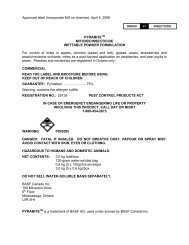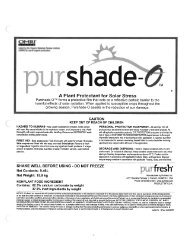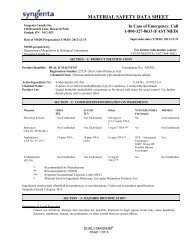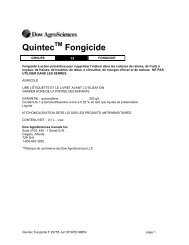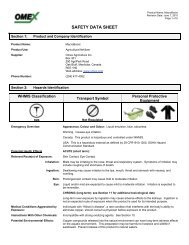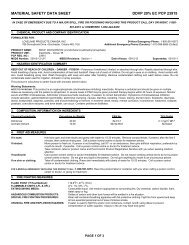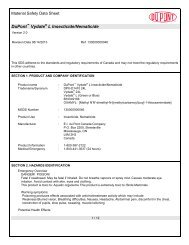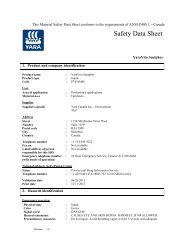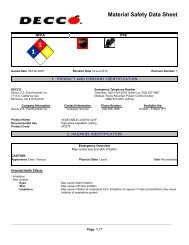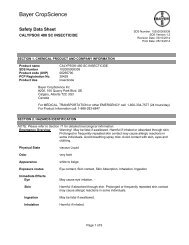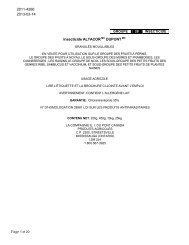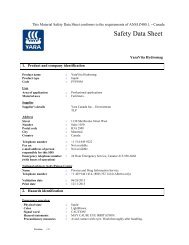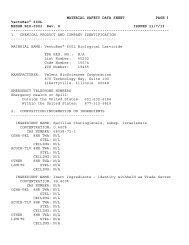Hydrochloric Acid msds english.pdf - Bartlett.ca
Hydrochloric Acid msds english.pdf - Bartlett.ca
Hydrochloric Acid msds english.pdf - Bartlett.ca
You also want an ePaper? Increase the reach of your titles
YUMPU automatically turns print PDFs into web optimized ePapers that Google loves.
<strong>Hydrochloric</strong> <strong>Acid</strong>, 30 - 40 %WHMIS Number : 00060172Page 2 of 9Skin Contact:Skin Absorption:Eye Contact:Ingestion:Other Health Effects:Brenntag Canada Inc.Date of Revision: 2011 January 10Corrosive! Burns <strong>ca</strong>n occur if not promptly removed. Concentrated solutions may <strong>ca</strong>use pain and deepand severe burns to the skin. Prolonged and repeated exposure to dilute solutions often <strong>ca</strong>usesirritation, redness, pain and drying and cracking of the skin. Toxic effects may be delayed. Avoid handlingwhen the skin is moist, wet or abraded.Skin absorption is a secondary concern to the continual destruction of tissue while the product is incontact with the skin. Prolonged or wide spread skin contact may result in the absorption of potentiallyharmful amounts of material.Extremely corrosive! This product <strong>ca</strong>uses corneal s<strong>ca</strong>rring and clouding. Glaucoma, <strong>ca</strong>taracts andpermanent blindness may occur.Corrosive! This product <strong>ca</strong>uses severe burning and pain in the mouth, throat and abdomen. Vomiting,diarrhea and perforation of the esophagus and stomach lining may occur. Prolonged or repeatedexposure may <strong>ca</strong>use discoloration and erosion of teeth.Corrosive effects on the skin and eyes may be delayed, and damage may occur without the sensation oronset of pain. Strict adherence to first aid measures following any exposure is essential.May <strong>ca</strong>use ulcers of the upper respiratory tract and pulmonary oedema. Pulmonary oedema is the buildupof fluid in the lungs that might be fatal. Symptoms of pulmonary oedema, such as shortness ofbreath, may not appear until several hours after exposure and are aggravated by physi<strong>ca</strong>l exertion. (4)4. FIRST AID MEASURESFIRST AID PROCEDURESGeneral Guidelines:Inhalation:Skin Contact:Eye Contact:Ingestion:Prompt removal of the material and obtaining medi<strong>ca</strong>l attention are essential for all contact. Remove allcontaminated clothing and immediately wash the exposed areas with copious amounts of water.Continue the flushing during transportation to the emergency department. Corrosive effects may bedelayed (up to 72 hours), and damage may occur without the sensation or onset of pain. Contact lo<strong>ca</strong>lpoison control centre for further guidance.Move victim to fresh air. Give artificial respiration ONLY if breathing has stopped. Give <strong>ca</strong>rdiopulmonaryresuscitation (CPR) if there is no breathing AND no pulse. Oxygen administration may be beneficial inthis situation but should only be administered by personnel trained in its use. Obtain medi<strong>ca</strong>l attentionIMMEDIATELY.Prompt removal of the material from the skin is essential. Remove all contaminated clothing andimmediately wash the exposed areas with copious amounts of soap and water for a minimum of 30minutes or up to 60 minutes for criti<strong>ca</strong>l body areas. Immerse the exposed part immediately in ice waterto relieve pain and to prevent swelling and blistering. Place cold packs, ice or wet cloths on the burnedarea if immersion is not possible. Cover the exposed part with a clean, preferably sterile, lint-freedressing. Obtain medi<strong>ca</strong>l attention IMMEDIATELY and monitor breathing and treat for shock for severeexposure.Immediately flush eyes with running water for a minimum of 30 minutes, preferably up to 60 minutes.Hold eyelids open during flushing. If irritation persists, repeat flushing. Do not transport victim until therecommended flushing period is completed unless flushing <strong>ca</strong>n be continued during transport.Do not attempt to give anything by mouth to an unconscious person. IMMEDIATELY contact lo<strong>ca</strong>l PoisonControl Centre. If victim is alert and not convulsing, rinse mouth out and give 1 to 2 glasses of milk.Water may be used if milk is not available but it is not as effective. If spontaneous vomiting occurs, havevictim lean forward with head down to avoid breathing in of vomitus, rinse mouth and administer moremilk or water. IMMEDIATELY transport victim to an emergency facility.



